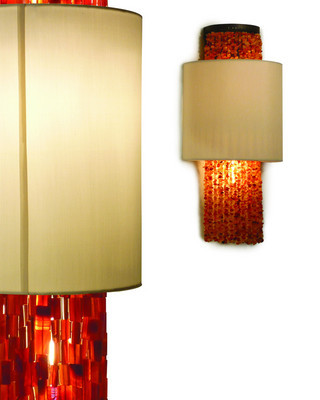Spotlight on design

At Mandalay Bay there is a fine-dining restaurant which, like a lot of Strip hot spots, pushes the envelope when it comes to interior design. With its all-white interior and sleek, space-age lines, it looks like a set from a James Bond film. You can almost picture 007 strolling down a stairway that curves through the center of the main dining room.
But the real drama comes from the chandelier — a 24-foot-tall piece with 15,000 hand-blown glass spheres that fill the room like champagne bubbles floating to the heavens. The light bulb has never looked so good.
Whether it’s high-end restaurants or home dining rooms, Thomas Edison would be amazed at how we are shading, emphasizing, coloring, embellishing and ogling over his invention in the name of design. It’s not just about seeing in the dark anymore, it’s about packaging light in such a way that creates an impact or, at the very least, adds to the tone of a room.
The growing emphasis on lighting is due to the availability of new materials and a steep rise in the number of companies manufacturing and selling fixtures. Businesses, from luxury hotels to chain grocery stores, also are influencing the nature of the industry with forward-thinking decorating schemes. And, of course, the do-it-yourself trends fueled by home-improvement stores and TV decorating shows doesn’t hurt.
“Homeowners are actually taking risks,” said Bobbie Jo Kinsey, principal designer with Las Vegas’ Bella Vita Interiors Inc. “Now it’s more about decoration and mood because with lighting you can create so many different scenes and scenarios. It’s always been functional but now it’s very decorative.”
Walk through a lighting retail store such as Northern Lights and Fans on South Eastern Avenue and the choices truly cross the spectrum. There are metal chandeliers that look like curled spaghetti and colorful Swarovski crystal pendants that dangle near the cash register like jewelry. There’s a 3-foot-tall sconce made out of real leaves tethered to twisted tree branches and, among the most popular fixtures right now, chandeliers of shiny, jet-black crystals.
In some cases, light fixtures are even being treated as works of art, taking their place as pieces of interest much like paintings on a wall.
Kevin Kolanowski spent two decades as an interior designer before starting his company, Fuse Lighting, in West Hollywood, Calif., eight years ago. The business makes fixtures based on Kolanowski’s designs using materials such as topaz, rock crystal, citrine, mica and even chain mail. His pieces can be whimsical, elegant and contemporary to the point of resembling modern art. And like any artist or designer, he gets his inspiration from the world around him.
His Vreeland chandelier is based on a photograph of a dress he saw in Vogue magazine because he “loved the way it draped on the woman’s body.” It’s made of shimmering mica squares and “cinches” in the middle like a dress might gather around a waist. He also makes a pendant light called Boa made of chain mail shaped into a snakelike tube and gathered at the bottom around a simple light bulb.
Most of his pieces are translucent and jewellike. The way they diffuse and refract light, or “throw wonderful shadows,” is just as important as the construction, according to Kolanowski. Put it all together and you have something that can stand on its own.
“Lighting is kind of a focal point so why not make it art, why not make it sculpture, why not make a statement,” he said.
According to Kinsey, it isn’t just the nature of fixtures that is changing. It’s also a matter of where the lighting is being placed.
Homeowners, for example, are putting chandeliers in closets and above bathtubs. Sconces are being used to enhance artwork along the walls, and dining rooms are becoming focal points for dramatic pieces in the vein of artists like Dale Chihuly, who created the chandelier of glass flowers hanging in the lobby of the Bellagio hotel.
Even baby nurseries are getting special treatment. During the past 10 years, there has been a significant jump in the amount of high-end fixtures created for children’s rooms, according to Andrea Edmunds, co-founder of PoshTots, which sells children’s furniture and accessories. Parents are building rooms around fixtures with hand-painted fish and ceramic safari animals, or sparkly crystals and beads.
Browse through the PoshTots’ Web site and there are pages and pages of whimsical table lamps, floor lamps, chandeliers and wall sconces, ranging from about $100 to nearly $2,000.
“I don’t think customers didn’t want (these fixtures) 10 years ago, it just wasn’t there 10 years ago,” Edmunds said. “And I think people are putting a lot more design elements in the rooms, and they want it to be an extension of all they have done to the rest of the house. Lighting has definitely come a long way.”












